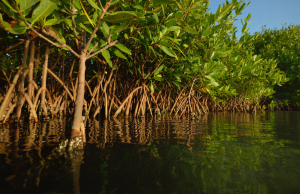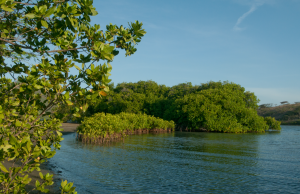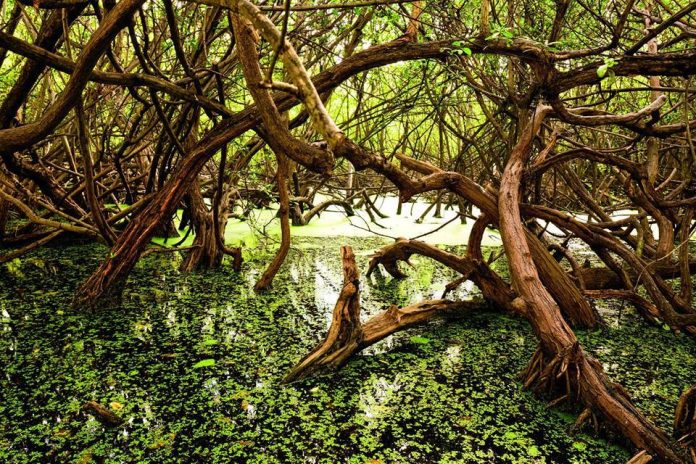Today marks the International Day for the Conservation of the Mangrove Ecosystem, adopted by the General Conference of UNESCO in 2015 and celebrated each year on July 26. With this, UNESCO aims to raise awareness of the importance of mangrove ecosystems as “a unique, special and vulnerable ecosystem” and to promote solutions for their sustainable management, conservation and uses. The most popular mangrove sites in Aruba would definitely be considered SPAANS LAGOEN & MANGEL HALTO in Pos Chikito.
Mangroves are rare, spectacular and prolific ecosystems on the boundary between land and sea. These extra ordinary ecosystems contribute to the wellbeing, food security, and protection of coastal communities worldwide. They support a rich biodiversity and provide a valuable nursery habitat for fish and crustaceans. Mangroves also act as a form of natural coastal defense against storm surges, tsunamis, rising sea levels and erosion. Their soils are highly effective carbon sinks, sequestering vast amounts of carbon.
Yet mangroves are disappearing three to five times faster than overall global forest losses, with serious ecological and socio-economic impacts. Current estimates indicate that mangrove coverage has been divided by two in the past 40 years.
UNESCO is engaged deeply in supporting the conservation of mangroves, while advancing the sustainable development of their local communities. The inclusion of mangroves in Biosphere Reserves, World Heritage sites and UNESCO Global Geoparks contributes to improving the knowledge, management and conservation of mangrove ecosystems throughout the world.
 Uses of mangroves
Uses of mangroves
Mangroves have been highly managed ecosystems since the dawn of time. Until the advent of synthetic lines the roots of the red mangrove (Rhizophora sp) were routinely used to strengthen natural fiber lines used in fishing. Traditionally they were used much more intensively than today for example in boat building and basket weaving as well as to produce charcoal.
Born survivors
In fact looking beyond the mud and the mosquitoes mangroves are fascinating ecosystems. They form dense, often impenetrable forests, choked with tangled prop roots and bathed in mud. Mangroves have evolved the amazing ability to thrive under extremely harsh conditions.
Not only can they tolerate high levels of salt but they are also able to cope with more or less constantly waterlogged soil. Needless to say there are not many of them, only 40 species have been recorded worldwide. Red mangroves (Rhizophera sp) survive by breathing through lenticels (pores) in their prop roots whilst black mangroves (Avecennia sp) send up a field of pneumatophores (aerial roots) around the trunk of the tree through which they breath. All species of mangrove extrude salt through their leaves, which is why the leaves glisten in sunlight. Living as they do, at the interface between land and water, mangroves provide a valuable service in protecting land from the buffeting power of the sea.
 Refugia
Refugia
In addition to resident plants and animals like killifish, tarpon (Megalops atlanticus), snook (Centropomus undecimalis), and mangrove snapper (Lutjanus griseus), mangroves provide a safe haven for nearly every kind of reef fish and many invertebrates at some time during their life.
Snorkelling throughmangrove is like visiting the reef in miniature. The young of cardinalfish (Apogonidae) snapper (Lutjanidae), grouper (Serranidae), wrasse (Labridae), pufferfish (Tetradontidae), boxfish (Ostraciidae), butterflyfish (Chaetodontidae), damselfish (Pomacentridae), scorpionfish (Scorpaenidae) and grunts (Haemulidae) all can be found milling around mangroves, darting in and out of their rootsy home. Some species such as the commercially important spiney lobster (Panulirus sp) use the mangrove to as spawning grounds. In all between 60 and 80 different species of fish can routinely be found in mangroves.
Prop roots
Mangrove prop roots form veritable oases of life. The roots themselves are smothered in encrusting life including mangrove oysters and barnacles, mussels and anemones, sponges, tunicates, stinging hydroids and worms.
Crabs are a ubiquitous feature of mangrove ecosystems. Grapsid crabs live underwater emerging at low water to feast on the mangrove forest floor. They are herbivores gobbling up detritus, leaves and seedlings. Fiddler crabs also forage on the mud but they are deposit feeders scooping up sediment and sifting through it for edible particles. The males have a huge, brightly coloured claw which is useless for feeding but vital when defending a territory or attracting a mate.
Importance of Mangroves:
– Mangroves provide an important breeding site for many species of migratory and non-migratory bird species
– Mangroves support a large range of wintering and foraging wetland birds
– Mangroves are an important nursery site for many aquatic species such as fish and crustaceans (i.e. crabs, shrimp, lobster)
– Mangroves provide harvestable products such as food, including fish and crustaceans
– Mangroves provide regulating functions such as carbon sequestration and water management: mangroves capture and store different forms of carbon responsible for climate change and slow the passage of water, collecting silt running off the land towards the sea
– Mangroves protect our coasts from erosion by waves and wind
– Mangroves provide for tourism, recreation and hiking
For this reason the Spanish Lagoon was designated a Ramsar site – a wetland site of international importance – in 1980 and brought under the protection of the National Park in 2017. Spanish Lagoon alone has a high biodiversity with 190 animal and 64 plant species recorded to date and provides ecosystem services that are important for the economic and social wellbeing of the island.
StimAruba, the organization that devotes herself to nature conservation and nature protection, would like to invite you to a walk to explore the 4 different types of mangroves called ‘Mangel” in Papiamento. This will take place today at 4:30pm starting at the ruins in Spanish Lagoon ‘Spaans Lagoon’.
It is of utmost importance that more mangrove areas of Aruba are brought under protection. Please appreciate our precious mangroves and help us to conserve our unique island nature!
Source: Dutch Caribbean Nature Alliance + (link) https://www.dcnanature.org/




















